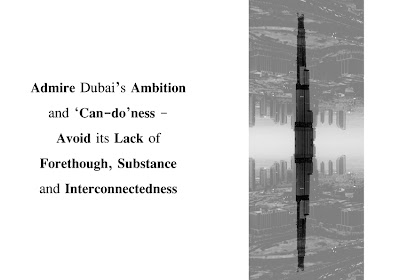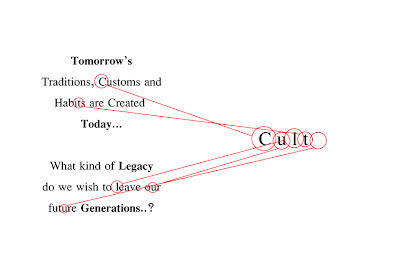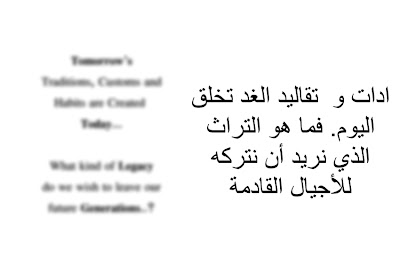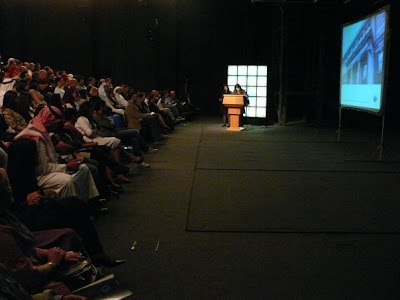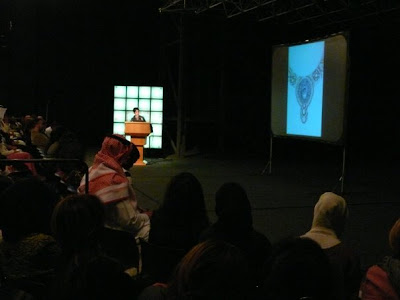The response to the Kuwait School Manifesto has been very gratifying, with reactions and feedback coming from as far and wide as the Gulf, Europe, States and Scandinavia. This is, however, only the beginning, and we've already got plans to both focus and expand on the programme set out by the manifesto. More about what that will entail in future blog submissions, but please continue to send your comments, suggestions and queries - the more this is discussed and debated, the merrier...
Tuesday, March 31, 2009
Sunday, March 22, 2009
The Kuwait School - The Gulf's First Design Manifesto...

The 'Kuwait School', is an eight point design manifesto (first of its kind in the region) outlining some key nodes and the spirit in which Kuwait, and perhaps even some of its neighbours, could/ should remodel their priorities and tackle various design related undertakings. This call-to-action was first announced at Kuwait's inaugural Pecha Kucha Night, which took place at the Dar Al-Athar Al-Islamiyyah Cultural Centre on March 11, 2009. Below is a summary of the manifesto's eight interrealted points, unveiled in the images in both English and Arabic, that aim to establish a recognizable cultural identity for contemporary Kuwait, something that still, as it stands, remains largely undefined...
The Kuwait School Manifesto aims to be critical, without being cynical, of where Kuwait currently stands, and aspires to provide a catalytic starting point for rekindling a more multifaceted, resonant, dynamic and self-sustaining Kuwait.
Maxim 1
We learn everything form history, this doesn't mean we have to duplicate it...
Image: A small hinged clog attached onto the inside frame of a window, which allows one to wedge the window open...
Our past contains the clues for how to conduct our present. However, these lessons need to be more suggestive rather than dictative in character. Excessive reverence for the past, without a smitten of demur, is never healthy. Thus, retaining and preserving samples of ones heritage is of key importance, recreating it less so. Our actions need to be reflective and in character with prevalent sentiments, social & cultural positions, environmental settings and perceptual preferences. The present, due to its capriciousness, makes the apparent certainty of a defined past attractive. It's a bias we should aim to resist, as the present-day is ours to shape, and that's very exciting and inspiring in itself...
Image: A design for a 3D printed mashrabiya customized to a specific location and particular condition...
Maxim 2
Admire Dubai's ambition and 'can-do'ness – avoid its lack of forethought, substance and interconnectedness...
Dubai is often cited as the default example of a successful reinvention of a city in the Gulf and Middle-Eastern region. Whilst there is much to applaud in Dubai's achievements, its determination, drive, and the sheer scale and zeal of the endeavour, much irredeemable harm has also resulted from its breakneck evolvement, be this in the removal of historical precedents, or the forcible application of, in the long run, excessive dependence of unsustainable interventions (mechanical air-cooling, desalination of sea water, lack of transport options, subsidized electricity & gasoline...), or the sheer impetuousness according to which the whole development has been managed. However, as useful a PR tool such an undertaking might be as an initial attention grabber, the biggest and the most outrageous usually has a short shelf-life, that, as a rule, is soon surpassed by another project more superlative in scale and aspiration. A successful design, regardless of size, needs to include a more multi-dimensional and comprehensive contextual approach from its foundations that verifies that the individual elements work, and are simultaneously considerate of the bigger picture.
Maxim 3
The value of good ideas needs to be acknowledged
A notion that is perhaps obvious to most readers, but it's surprising how often, be it due to convenience, ignorance, lack of imagination, or just plain apathy an existing rendition of dubious value is applied, and re-applied, without much forethought in the realization of a design. Perhaps one of the problems is that, be it considered in reference to industrial or urban design, often a successful design remains invisible, and we only notice them when they don't work, or when a comparative project is badly designed. An i-pod can be appreciated due to how well its technology seems to be inherently entwined, through its user interface, to the engineering of the piece as well as, maybe more importantly, to the tectonics of the hand (and pocket) and the way such physical factors are matched with the patterns of intuitive usage (the scrolling and matching 'clicking' sound of the device's circular control wheel). Cities such as Barcelona, Berlin, Helsinki, Kyoto or Hamburg get, year after year, voted as the most habitable and interesting places to live due to their ability to successfully balance and integrate the myriad of interconnected elements, from cleanliness, safety, access/ public transport, expense of living, green areas, etc., that make a city prosperous and a pleasant to inhabit. A notable design needs to consider all such , both positive as well as any more negative, aspects in its implementation. This requires, along with stimulating ideas and know-how, an abundance of perseverance, commitment and credence...
Maxim 4
Kuwaitis already have a fascination with 'newness', this should be reformulated from a mere material(ist) sentiment into a desire for innovation and the creation of the novel.
Image: The plastic is left on the seats of an, assumedly, recently purchased car.
The excessive 'hoarding' and consumerist impulse (buying for buyings sake), which is currently particularly prevalent in Kuwait, will eventually become, if it isn't already, a counter-productive endeavour. An act which involves no personal commitment beyond the desire for possession is inevitably impossible to satisfy. In the end, it's what one does, not what one owns, that matters. Achieving something that requires effort and perseverance is always more satisfying than gaining something by default. This requires a mindset adjustment, where the notions of 'homo faber' (man the maker) and 'homo ludens' (man the player) unite and are adapted into more craft oriented pursuits where the process of making something, making something original, and making it well, is an aspiration and worthy avocation in its own right (and, who knows, it might be a first step towards lessening Kuwait's excessive dependence on imports)...
Image: A weathered salt sculpture on display in the courtyard of the nous Gallery, London, April – May, 2008.
Maxim 5
One can have faith in technology without being a slave to it. Develop know-how and expertise whilst remaining receptive and open to alternatives...
Image: Archipelago Mashrabiya – a privacy & shading screen made out of three matching, laser-cut, sandwiched layers of canvas...
How far could one get in Kuwait without the use of a personal car? Even though today a generic car is not necessarily the epitome of advanced technology, it is, however, in the context of Kuwait, a appropriate illustration of a nation in utter dependence on a particular technology – a necessity without which the country would come to a (literal) standstill. It's important to establish a less loop-sided balance between us and the objects and environments (tools, devices, means of transport, habitats) we use and occupy. In the context of the aforementioned example, it's important to provide for alternate means of transport (trains, metro, trams, buses), transport usage formats (bus lanes, congestion charges), as well as the enforcement of the most beneficial usage patterns (the rules & laws) such operations entail to be successful - with particular allowances for walking, and aim to do so whilst recognizing, understanding and retaining some of the qualities that have made the act of driving so essential, and occasionally enjoyable, in Kuwait in the first place.
However, on a more general level, the notion of technology needs to move beyond such limited semantic affiliations and definitions, refocusing the noun of 'technology', into the verb of its Greek origin, 'techne', that entails the practical application of a craftmanship, skill or art. This approach doesn't limit development to a particular discipline (such as engineering or science), but commingles a variety of branches of knowledge and practice, preferences and sensitivities into a more inclusive and multi-dimensional whole. This syncretic approach can be applied to a design regardless of size or purpose, and is an essiential component in the development of a culture where variation, individuality and experimentation is allowed, even encouraged - a spirit and approach that is key in the development and maintenance of a dynamic and prosperous society.
Image: Bubble Mashrabiya (explanation as above)...
Maxim 6
Tomorrow's traditions, customs, and are created today... What kind of legacy do we wish to leave our future generations..?
A contemporary Kuwaiti adage holds that one of the best things about Kuwait is how easy it is to leave Kuwait. This sentiment seems to be quite prevalent, as the country becomes quite a solitary place around the holidays. Why isn't Kuwait considered a worthy destination by residents and non-residents alike? How could Kuwait be amended to become a more attractive and dynamic destination to visit and place to inhabit? This form of insipidity can be interpreted as a dearth of imagination and a general stagnation in getting proposals implemented. The current situation is unfortunate, as it also reflects an inherent lack of faith, and a fair dollop of laissez faire-ness, in the nation's ability to manage and develop itself. If Kuwait, from a design perspective, is to become a city and nation of an internationally respectable standard, a place its future habitants will willingly occupy, it needs to tackle its entwined debilities on the micro, meso and macro scale. This would involve fixing the unreasonably entangled and rigid bureaucracy that seems to ensnare all branches of governance (as well as the lax attitude that allowed it to become such a quagmire in the first place), to resolving the somewhat blurred allocations of responsibility and chains-of-command at the higher echelons of decision making. For only through such actions of accountability can viable and considerate designs, regardless if its for a park-bench or the UDP (Unitary Development Plan) for a new township, come about. These actions require time and interdependent thought and design, making it essential, for the sake of Kuwait, these are considered immediately rather than later. Our futures are made today.
Maxim 7
Why shouldn't the notion of 'Made in Kuwait' be a label representing worldclass innovation and quality?
There is no reason why Kuwait couldn't internationally be known for more than its oil. There is no reason why Kuwait couldn't become the producer of worthwhile and inspiring designs of various scales and intents, and do so in a fashion that would retain a distinct 'essence' (a Kuwaiti 'look', 'sound', 'flavour') of its own. There is no reason for why Kuwait couldn't be leading the way, rather than a following in the (branded) footsteps, in realizing praiseworthy, intellectually challenging and inspiring, architecture and design. Why couldn't the local industry and know-how, in all stages of the production cycle, be re-configured according to a more effective and affective template? What should a diwaniya of the 22nd century be like? How could the streamlined properties of a dhow be utilized in the design of a carbon-fibre hull of a speedboat? How will the flavour of majboos change, or be adjusted, with times? How will sawt sound like when interpreted by individuals of alternate backgrounds and sensitivities? How could the unique qualities of the local social settings, cultural particulars and habitable vernacular be learnt from, and be utilized and eventually even be exported, to benefit a wider scope of individuals..?
Maxim 8
Kuwait – the design capital of the Middle-East?!
In the eyes of the world, and in the context of its neighbouring nations, there's still a position free for Kuwait, as the Design Capital of the Middle-East. If Dubai (with all its 'over-the-topness') is defined as the Las Vegas of the Middle-East, Sana'a (which still retains a substantial quantity of traditional buildings and narrow pathways) as the Venice of the Middle-East, and Cairo as the Hollywood of the Middle-East, there is nor reason why Kuwait, with its established craft heritage and existing pool of skilled craftsmen, carpenters and builders, couldn't develop into the 'Milan' of the Middle-East.
No nation wellbeing should be so dependent on the price fluctuations of a single product. It's time to diversify and to begin building alternative paradigms of know-how and industries. Design, through all its renditions, of product, furniture, fashion, literature, graphics, architectural design (to mention a few) is a brilliant place to start. There is genuine talent and skill in Kuwait and the region, this needs to be acknowledged, celebrated, developed, promoted, and supported. Who knows, perhaps in a few decades the analogy can be inverted, where Milan will be referred to as the 'Kuwait of Europe'...
Click here for a youtube video of the original Pecha Kucha presentation. Click here for a review in the (British) Building Design magazine, and here for a piece in Artvark...
For a PDF version of the above, please contact the author...
Copyright - Thomas Modeen 2009
Monday, March 16, 2009
KASA Exhibition at the Al-Corniche Club...
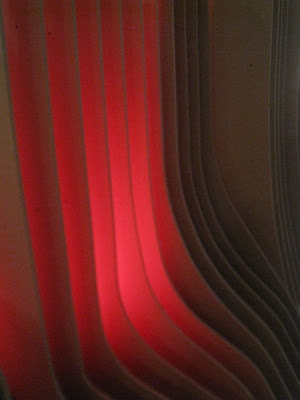
Visited tonight the KASA exhibition at the Al-Corniche Club by the Gulf Road. It was terrific, even though perhaps a bit melancholy, to see the students and other familiar faces from last term. But the exhibition looked great, and the effort and care the students had put into making it happen was very evident. Congratulations to you all... Below are some additional images from the evening.


Thursday, March 12, 2009
Doing the Pecha Kucha in Kuwait...

Kuwait's first Pecha Kucha Night was great! The mix of presenters, the quality of work and ideas displayed, and the response by the audience was all very catalytic. Let's hope this, as well as the future PKN events, will trigger off some form of a heightened awareness of all the issues raised and interests discussed and debated. Thanks Dr. Asseel for a brilliant event!
Please click here for a review of the event in Kuwait Times, click here for the review in Arab Times, here for one in Artvark, here for 29.20'N, 47.59'E, and here for a blog review in Art for Arabs... There is also a snippets from the event on youtube, TM's presentation can be viewed by clicking here.
Below are some additional photos of yesterday's worthy happening.
(All photos, except when otherwise credited, by Rashed Al Foudari)
More of our presentation, titled 'The Kuwait School (of thought) - the Kuwait's/ the Gulf's First Design Manifesto', in an upcoming blog submission...
Please click here for a review of the event in Kuwait Times, click here for the review in Arab Times, here for one in Artvark, here for 29.20'N, 47.59'E, and here for a blog review in Art for Arabs... There is also a snippets from the event on youtube, TM's presentation can be viewed by clicking here.
Below are some additional photos of yesterday's worthy happening.
(All photos, except when otherwise credited, by Rashed Al Foudari)
More of our presentation, titled 'The Kuwait School (of thought) - the Kuwait's/ the Gulf's First Design Manifesto', in an upcoming blog submission...
Wednesday, March 11, 2009
'The Seeing Touch' - An Article in T-Square Magazine...

We've had a short piece on skin & architecture, titled 'The Seeing Touch', published in the latest issue of T-Square Magazine, a very worthy publication run and managed by students of the Department of Architecture at Kuwait University. We think the spread looks just grand!
We also wish to thank the magazine's Editor, Ruba Al-Saleh, for allowing us to contribute and, as this is her parting issue (she is graduating this year) we wish her continued success in her future endeavors.
The magazine can be picked up at Kuwait University, and many a worthy gallery and coffee-house around (Kuwait) town...
To view the article in more detail please 'click' on the image above...
We also wish to thank the magazine's Editor, Ruba Al-Saleh, for allowing us to contribute and, as this is her parting issue (she is graduating this year) we wish her continued success in her future endeavors.
The magazine can be picked up at Kuwait University, and many a worthy gallery and coffee-house around (Kuwait) town...
To view the article in more detail please 'click' on the image above...
Saturday, March 7, 2009
KASA's 6th Annual Exhibition...

KASA (the Kuwait Architectural Students Association) is holding its sixth annual exhibition here in Kuwait, starting on the 16th of March, at the Al-Corniche Club Exhibition Hall by the Gulf Road (beach side). Some of my former students from the KU Architectural Department are part of the team setting this up, and I've been in the privileged position of following the progress of this project, and the effort and commitment these aspirant architects have dedicated to it (mostly worked out during their term break), which is predominantly made up of an assembly of sequential, CNC milled, MDF profiles on which (and in between which) the work will be displayed. I'm really exited to see how it all comes together.
If you're in the region you should definitely stop by and take a look at the catalytic work of these budding creatives...
Tuesday, March 3, 2009
Kuwait's First Pecha Kucha Night...
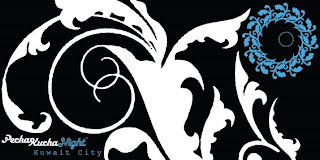
Kuwait's first Pecha Kucha Night, hosted by Dr. Asseel Al-Ragam, will take place next Wednesday, March 11, at 7 pm, at the Al-Maida Cultural Centre, Abdullah al-Salem School, Maidan Hawalli, Near al Sha'ab Leisure Park.
We've had the honour of being invited to present at this inaugural event (amongst other worthy presenters), which is something we're very excited about, and truly looking forward to, as it's the type of engagement that Kuwait is in sore need of...
So, if you happen to be in the region and by chance have a free evening, please join us...
We've had the honour of being invited to present at this inaugural event (amongst other worthy presenters), which is something we're very excited about, and truly looking forward to, as it's the type of engagement that Kuwait is in sore need of...
So, if you happen to be in the region and by chance have a free evening, please join us...

Subscribe to:
Posts (Atom)




